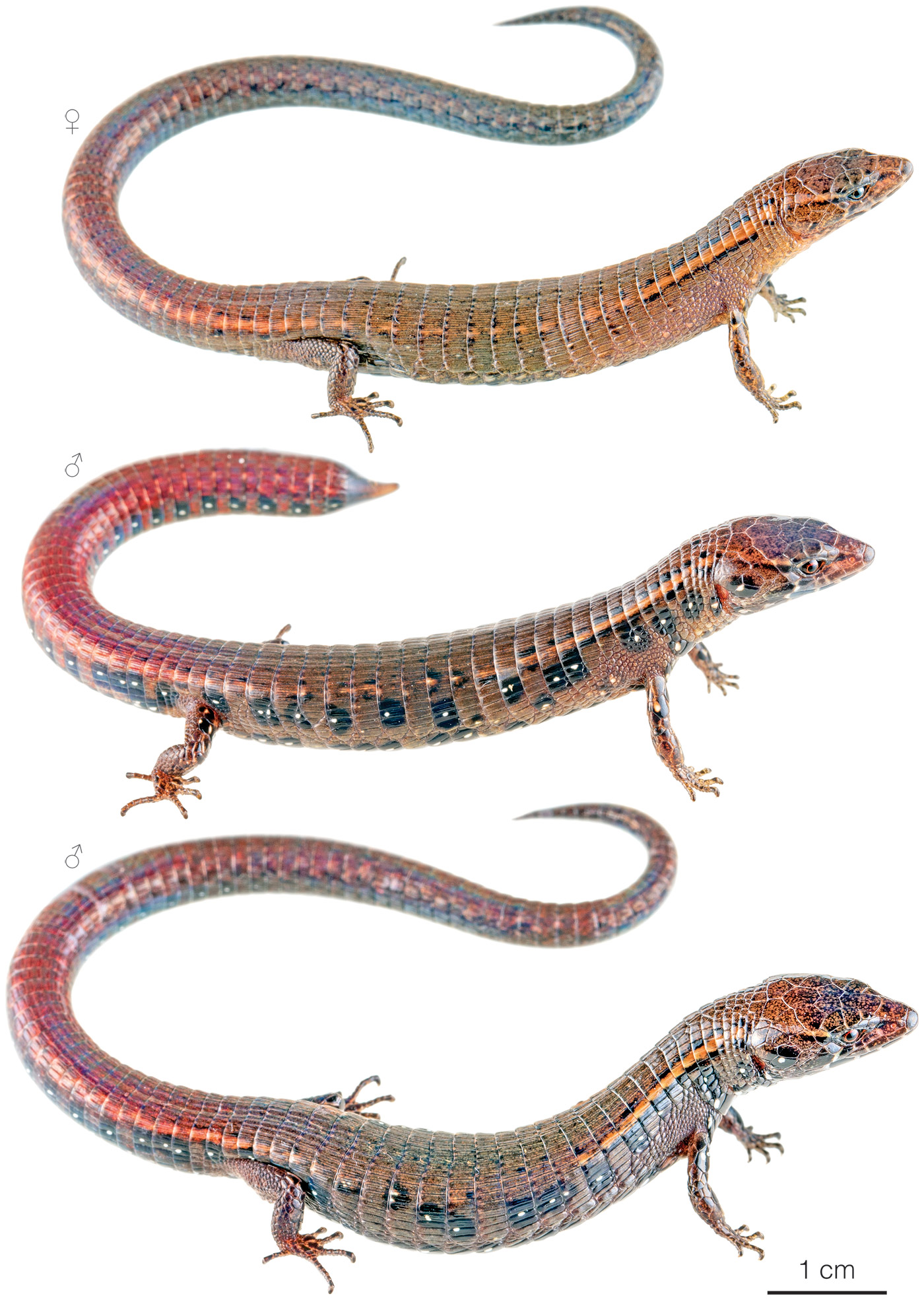Published August 31, 2020. Updated November 17, 2023. Open access. Peer-reviewed. | Purchase book ❯ |
Kizirian’s Andean-Lizard (Andinosaura kiziriani)
Reptiles of Ecuador | Sauria | Gymnophthalmidae | Andinosaura kiziriani
English common names: Kizirian’s Andean-Lizard.
Spanish common names: Lagartija andina de Kizirian.
Recognition: ♂♂ 14.4 cmMaximum distance from the snout to the tip of the tail. Snout–vent length=6.6 cm. ♀♀ 16.7 cmMaximum distance from the snout to the tip of the tail. Snout–vent length=6.1 cm..1,2 The Kizirian’s Andean-Lizard (Andinosaura kiziriani) differs from all other lizards in its area of distribution by lacking prefrontal scales and having extremities so short that the front and hind limbs do not overlap when pressed against its body.1 Adult males are more robust than females and are easily recognizable by their reddish tails and flanks having ocelli consisting of a black circle with a white spot in the middle (Fig. 1). Adult females are brownish overall and lack ocelli.2

Figure 1: Individuals of Andinosaura kiziriani from Bosque de Jerez, Azuay province, Ecuador.
Natural history: Andinosaura kiziriani is a rarely seen cryptozoic (preferring moist, shaded microhabitats) lizard that inhabits old-growth to heavily disturbed evergreen high montane forests, cloud forests, highland shrublands, planted pine forests, and forest borders, usually close to bodies of water such as waterfalls and streams.2–4 Kizirian’s Andean-Lizards spend most of their lives hidden under soft soil, leaf-litter, rocks, and logs,1–4 but may also occasionally be seen moving at ground level during the day.4 When threatened, individuals of A. kiziriani flee into crevices. If captured, they may bite or readily shed the tail.2
Conservation: Endangered Considered to be facing a high risk of extinction in the near future..5 Andinosaura kiziriani is listed in this category because the species is known from only five populations and is restricted to a small (approximately 1,305 km2) area that has lost about 63.3% of its natural vegetation cover.6 The habitat of A. kiziriani is severely fragmented and continues to decline in extent and quality due to encroaching human activities such as agriculture, cattle grazing, and the replacement of native vegetation with eucalyptus and pine trees.2,5
Distribution: Andinosaura kiziriani is endemic to an area of approximately 1,305 km2 along the Pacific slopes of the Andes in southwestern Ecuador (Fig. 2).

Figure 2: Distribution of Andinosaura kiziriani in Ecuador. The star corresponds to the type locality: San Antonio, Azuay province. See Appendix 1 for a complete list of the presence localities included in the map.
Etymology: The generic name Andinosaura, which comes from the Spanish word andino (from the Andes) and the Latin sauria (meaning “lizard”), refers to the distribution of this group of lizards.7 The specific epithet kiziriani honors United States herpetologist David Kizirian, of the American Museum of Natural History, in recognition of his contribution to the knowledge of Andean lizard diversity.1 In 1996, Kizirian published the most comprehensive monograph on Ecuadorian burrowing lizards, in which he described nine new species to science.8
See it in the wild: Kizirian’s Andean-Lizards are recorded rarely unless they are actively searched for by digging in areas of soft soil or by turning over rocks and logs. At the localities known as “Bosque de Jerez” and “Chorro de Girón,” a targeted search by a group of field biologists lasting an entire day usually results in 4–6 individuals of this shy species.
Acknowledgments: This account was published with the support of Secretaría Nacional de Educación Superior Ciencia y Tecnología (programa INEDITA; project: Respuestas a la crisis de biodiversidad: la descripción de especies como herramienta de conservación; No 00110378), Programa de las Naciones Unidas (PNUD), and Universidad San Francisco de Quito (USFQ).
Author: Alejandro ArteagaaAffiliation: Fundación Khamai, Reserva Arlequín, Ecoruta Paseo del Quinde km 56, Santa Rosa de Mindo, Pichincha 171202, Ecuador.
Academic reviewer: Jeffrey D CamperbAffiliation: Department of Biology, Francis Marion University, Florence, USA.
Photographer: Jose VieiracAffiliation: Tropical Herping (TH), Quito, Ecuador.,dAffiliation: ExSitu, Quito, Ecuador.
How to cite? Arteaga A (2023) Kizirian's Andean-Lizard (Andinosaura kiziriani). In: Arteaga A, Bustamante L, Vieira J (Eds) Reptiles of Ecuador: Life in the middle of the world. Available from: www.reptilesofecuador.com. DOI: 10.47051/RWUL2792
Literature cited:
- Sánchez-Pacheco SJ, Aguirre-Peñafiel V, Torres-Carvajal O (2012) Lizards of the genus Riama (Squamata: Gymnophthalmidae): the diversity in southern Ecuador revisited. South American Journal of Herpetology 7: 259–275. DOI: 10.2994/057.007.0308
- Field notes, Reptiles of Ecuador book project.
- Field notes of Jorge Luis Romero.
- Falcón JM, Sánchez-Nivicela JC (2020) Description of the topotypic Andinosaura kiziriani (Sauria: Gymnophthalmidae) female from the Girón sector, Ecuador. Avances en Ciencias e Ingeniería 12: 34–39. DOI: 10.18272/aci.v12i1
- Cisneros-Heredia DF (2019) Riama kiziriani. The IUCN Red List of threatened species. Available from: www.iucnredlist.org.
- MAE (2012) Línea base de deforestación del Ecuador continental. Ministerio del Ambiente del Ecuador, Quito, 30 pp.
- Sánchez‐Pacheco SJ, Torres‐Carvajal O, Aguirre‐Peñafiel V, Sales-Nunes PM, Verrastro L, Rivas GA, Rodrigues MT, Grant T, Murphy RW (2017) Phylogeny of Riama (Squamata: Gymnophthalmidae), impact of phenotypic evidence on molecular datasets, and the origin of the Sierra Nevada de Santa Marta endemic fauna. Cladistics 34: 260–291. DOI: 10.1111/cla.12203
- Kizirian DA (1996) A review of Ecuadorian Proctoporus (Squamata: Gymnophthalmidae) with descriptions of nine new species. Herpetological Monographs 10: 85–155. DOI: 10.2307/1466981
Appendix 1: Locality data used to create the distribution map of Andinosaura kiziriani in Ecuador (Fig. 2). Go to the section on symbols and abbreviations for a list of acronyms used. Asterisk (*) indicates type locality.
| Country | Province | Locality | Source |
| Ecuador | Azuay | Bosque de Gerez | This work; Fig. 1 |
| Ecuador | Azuay | Cerro El Mozo | Photo by Jorge Luis Romero |
| Ecuador | Azuay | El Chorro de Girón | Falcón & Sánchez-Nivicela 2020 |
| Ecuador | Azuay | La Enramada | INABIO 2019 |
| Ecuador | Azuay | San Antonio* | Sánchez-Pacheco et al. 2012 |
| Ecuador | Azuay | Ucumari | Reptiles of Ecuador book database |